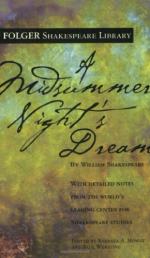|
This section contains 5,045 words (approx. 17 pages at 300 words per page) |

|
SOURCE: "Bottom is Up: The Role of Illusion in A Midsummer Night's Dream," in Essays in Arts and Sciences, Vol. XVI, May, 1987, pp. 9-21.
In the following essay, Shulman studies the relationship between illusion, love, and art in A Midsummer Night's Dream, arguing that the "process of illusion" offers insight into both love and art, and that Shakespeare uses illusion to guide his characters to more mature perspectives about love and marriage.
Like Hermia, the student of A Midsummer Night's Dream needs to see "with parted eye" (IV.i.188)1 for the Dream has a double focus. It is on the one hand about love and the relationship of the varieties of love experience to marriage; on the other hand, it is about art and the uses and abuses of artistic expression, and particularly the dramatic experience. The "concord of this discord" (V.i.60) lies in the concept of...
|
This section contains 5,045 words (approx. 17 pages at 300 words per page) |

|


